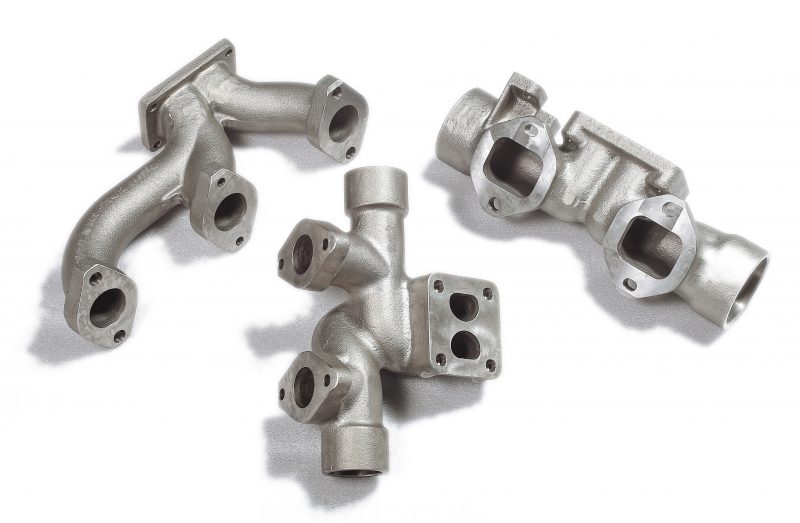Sand Casting Ductile Iron – Process Capabilities and Limitations
Carbon steel is not easy to sand cast due to its high melting point. Ductile cast iron is an alternative. Its lower melting point provides a way of achieving similar metallurgical properties to those of steel in a sand cast part. Switching from steel to ductile iron castings is a way to reduce machining requirements and perhaps also piece cost.

Here’s an introduction to ductile cast iron and an explanation of what’s involved in sand casting it.
Two Types of Cast Iron
Foundrymen have been making and working with gray cast iron for centuries. It melts and casts readily and has good machinability but its downfall is low tensile strength and ductility.
The low strength is caused by flakes of graphite distributed throughout the metal matrix. These provide crack initiation points that lead to weakness.
Ductile cast iron, developed during the mid-twentieth century, overcomes this problem. Adding small quantities of carefully selected elements to carbon-rich high quality pig iron creates tiny graphite spheres in a matrix of ferrite and pearlite (Fe3C) instead of flakes. For this reason, it’s sometimes referred to as spheroidal or nodular cast iron.
Ductile cast iron is slightly less dense than steel, (0.256 lb/in3 / 7.1 g/cm3 versus 0.284 lb/in3 / 7.8 g/cm3), and therefore lighter, yet tensile strength is very similar. It has moderately good ductility, good wear resistance, and can absorb shock loads.
The Sand Casting Process
Sand casting starts with a pattern that replicates the part being cast. This is placed into a box which is packed with sand. The pattern is then taken out to leave a cavity that will be filled with metal.
The box, technically, a “flask,” comprises two halves, an upper “cope” and a lower “drag.” Passages are formed in the cope where metal will flow in, and excess metal will rise up once the cavity is filled. These are the runners and risers.
Once the metal has solidified, the sand is shaken out, and the casting is sent for runner and riser removal before being machined.
Ductile Iron and Sand
Sand plays a vital role in the casting process. Being slightly permeable, it allows gas to move out while at the same time chilling the liquid metal, which solidifies from the outside in. Packing density and sand composition must be managed carefully to ensure consistent metal shrinkage and part quality.
Ductile iron is usually cast in green sand containing around 5% coal dust. “Green” in this context refers not to the color but to the moisture content. “Green” sand is sand which has not been through a drying process.
In addition to the sand itself, green sand for casting contains a proportion of bentonite clay. This acts as a binder and holds the packed sand together in the flask.
Coal dust, sometimes called “sea coal,” is an important constituent of sand for casting ductile iron. Its role is to produce a reducing atmosphere that takes up oxygen released when hot iron comes into contact with the sand. It slows expansion and results in smoother, cleaner cast surfaces with less burnt-on sand. Casting sand containing coal dust is easily recognized by its gray or almost black appearance.
Cast Iron Inoculation
Two processing steps are key to making cast iron parts that can compete with steel. These are inoculation and magnesium treatment. For the best quality ductile cast iron they are carried out just before pouring.
Inoculation addresses the tendency of carbon to precipitate out as graphite flakes. It entails adding small quantities of specially selected alloys that provide points for the carbon to nucleate on or crystallize. This prevents the formation of the flakes that are detrimental to strength and ductility.
In a similar way, magnesium is added to “mop up” any sulfur in the iron. As with inoculation, this improves the mechanical properties of the resulting metal.
Capabilities and Limitations
Ductile sand casting is ideal for producing cast iron parts that can compete with steel. Shrinkage allowances and draft angles are required to create quality parts and secondary machining will almost always be needed to add precision features like holes and mounting surfaces. In addition, thin sections are impractical. However, good surface finishes are obtainable with the use of coal dust.
Sand casting offers little limitation to the size of parts that may be cast. Small parts weighing less than one pound (0.5kg) cast as well as those weighing hundreds of pounds and measured in feet.